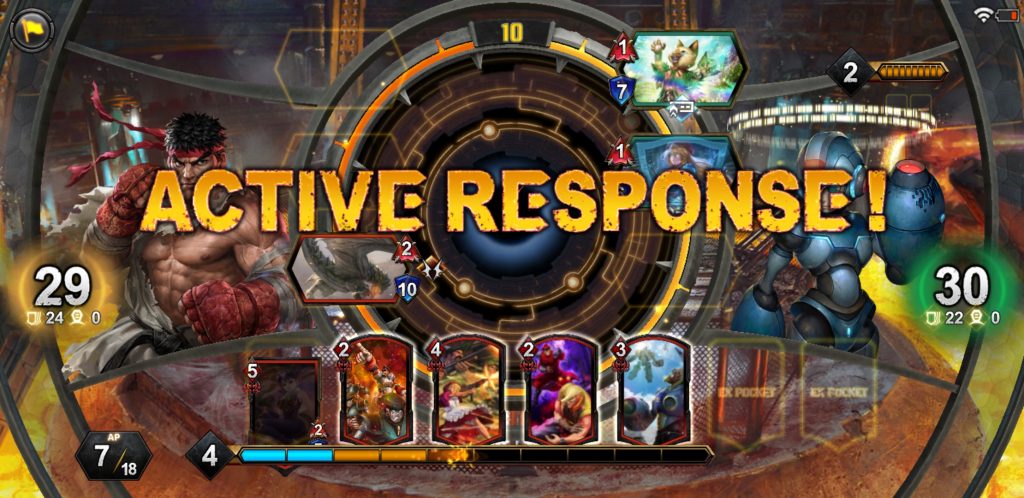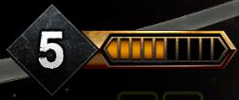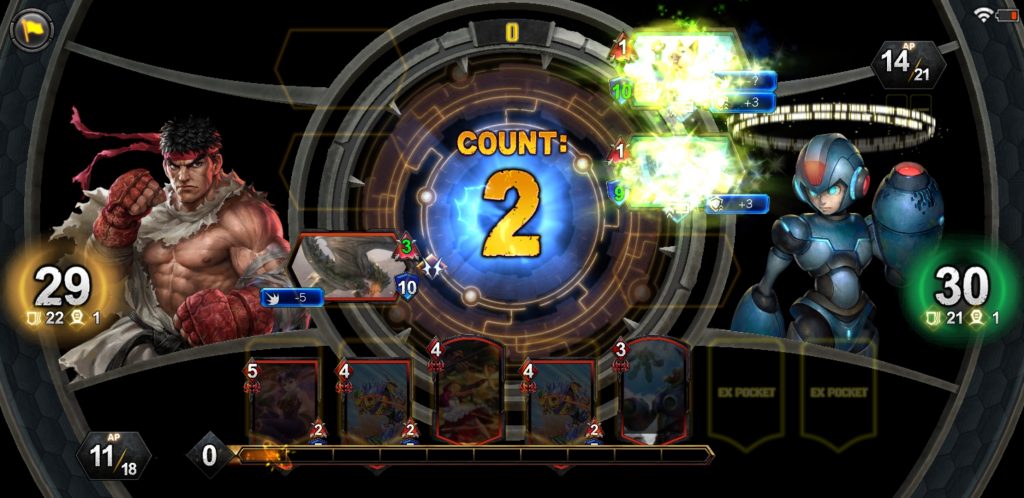This article will introduce Active Response, one of TEPPEN’s special systems.
Active Response is a turn phase that allows players to have fun by quickly playing cards.
Here, I will talk to you in more detail about Active Response and what it entails.
Summary
- You and your opponent can take turns playing action cards during Active Response.
- The effect of cards played last has priority over other cards during Active Response.
- AMP is added to your normal MP only during Active Response, and you can use it to play a card.
1. Active Response

Playing Action Cards will trigger Active Response.
The timer stops during Active Response, and every unit’s attack gauge and MP accumulation is also halted.
During Active Response, the battle time display is replaced by a time left display.
You and your opponent are given 10 seconds per turn and take turns playing Action Cards.
Once you play an Action Card, it will then be your opponent’s turn, during which you will have to wait for his reaction.
Playing Action Cards reduces MP in the same way that playing Unit Cards does.
If you do not have an Action Card you can play, you can press the Cancel icon on the bottom left corner of the battle screen to end Active Response.
Active Response will also end if the time left reaches 0 while you’re choosing a card.
When Active Response ends, Action Cards will take effect in order starting with the last card played.
More information on the activation order of effects can be found in 2. Effect Activation Order.
When the activation of effects ends, the halted battle time, attack gauge, MP accumulation resumes.

Your opponent’s MP is displayed in the top right corner of the screen during Active Response.
Your MP is also displayed to your opponent, so that you’re both able to predict what cards might be played based on the MP that remains.
2. Effect Activation Order

An important aspect of Active Response is the order in which the effects of cards played are activated.
The effects of Action Cards are activated in the opposite order of which they are played.
In other words, the cards played last will take effect before the cards played before them.
If you pay attention to the order in which the effects will activate, you can turn things around on your opponent.
-Active Response Turnaround Examples
-
- In response to your opponent playing an Action Card that “inflicts three damage on a single enemy unit,” you play a card that applies a “shield (reduces damage received to 0 once)” to the same unit.
Because the damage effect will not occur until after the shield effect, the damage is prevented. - In response to your opponent playing an Action Card that “destroys a single enemy unit with Attack of one or less,” you play a card that has an effect like “+2 Attack to a single unit”.
The target no longer has an Attack of one or lower and survives the effect of your opponent’s Action Card.
- In response to your opponent playing an Action Card that “inflicts three damage on a single enemy unit,” you play a card that applies a “shield (reduces damage received to 0 once)” to the same unit.
An explanation of the effect of the card played by your opponent is displayed on the upper part of your opponent’s hero.
In the ten seconds available, calmly make note of your opponent’s effect, and choose an Action Card that can effectively counter it.
3. AMP

AMP refers to MP that can only be used during Active Response.
When entering Active Response, each players normal MP is added to their AMP.
The AMP addition is displayed in blue within the MP bar on the bottom of the battle screen.
After that, whenever you play an Action Card, AMP will first be consumed, followed by normal MP when there is no AMP left.
The addition of AMP makes high cost MP Action Cards easier to play.
*Because AMP is added after Active Response is activated, AMP is not applied to the Action Card played when entering.
AMP disappears and can no longer be used when Active Response ends.
Conclusion
Two important aspects of Active Response are “the AMP increase to your MP” and “the order of the action cards you play.”
As an example of how to think during Active Response…
“Because AMP is added, it might be better to wait for my opponent to play first than to initiate Active Response myself.”
“If I played this card, my play this card in response, so I’ll get a card that can resist that response.”
Etc.
Use predictions like these to come up with a winning strategy.
A commanding performance in Active Response will take you all the more closer to victory.
Continue to the next article for more info on the game!
